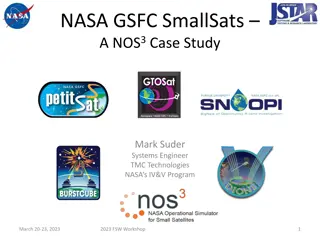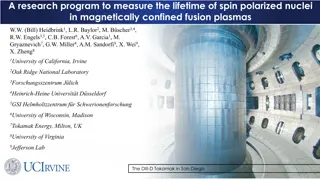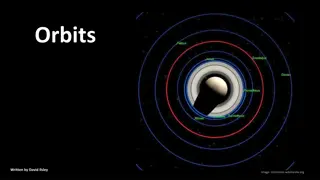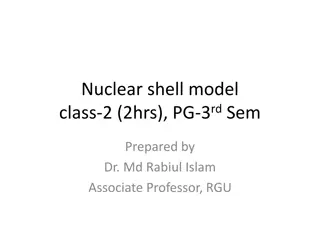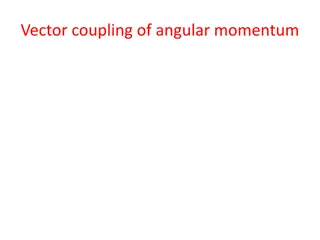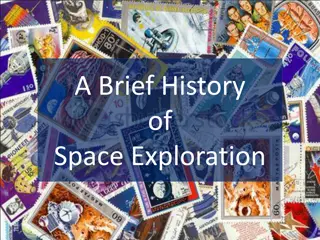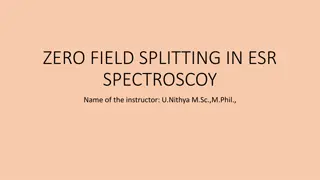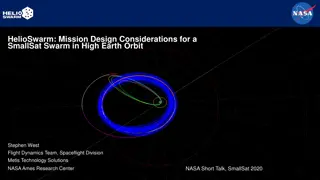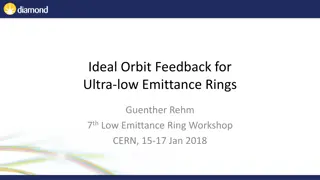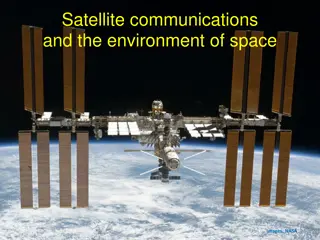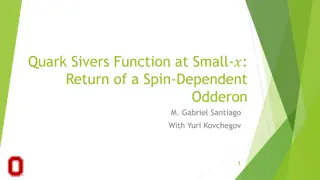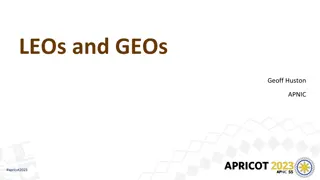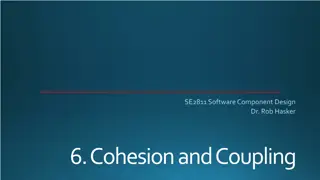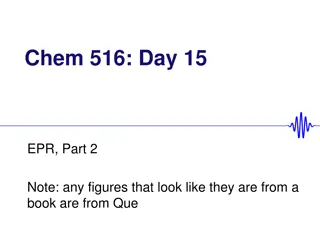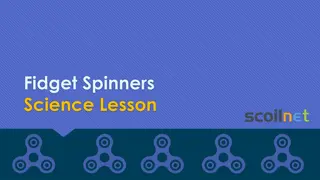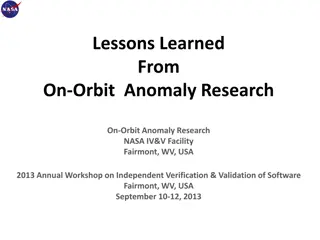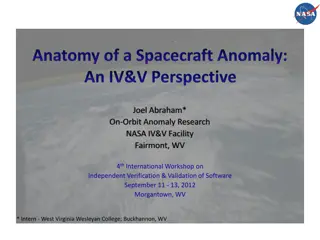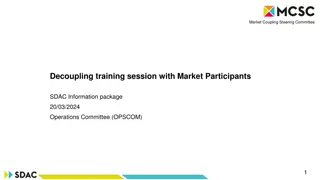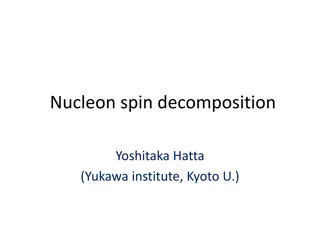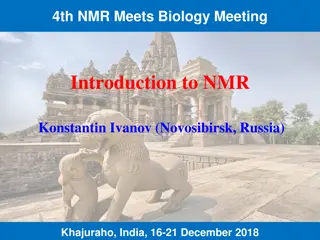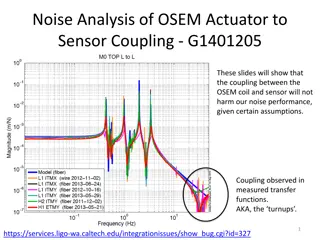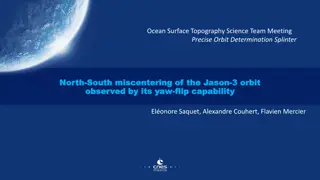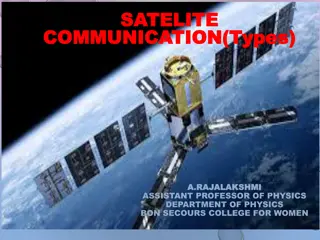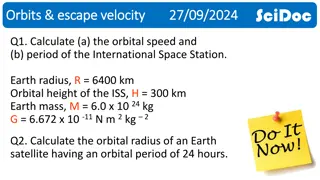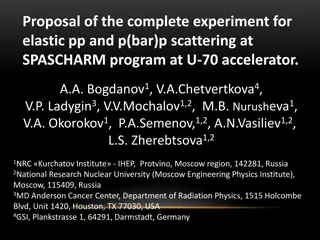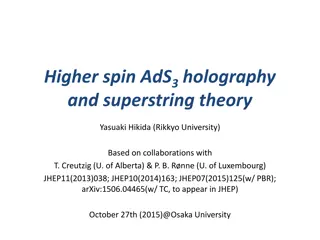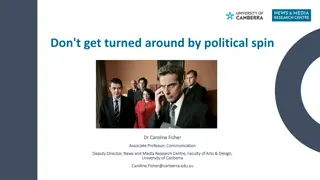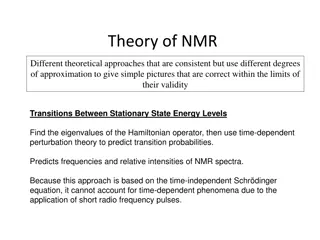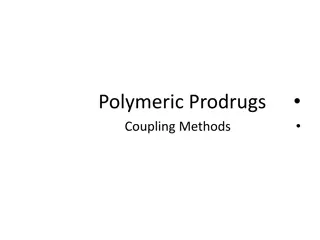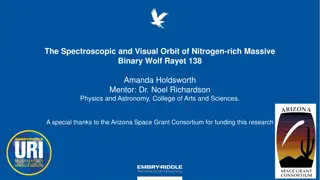NASA SmallSat Development: FSW Workshop Insights
Delve into NASA's SmallSat development through the eyes of systems engineers and software experts. Explore NOS3 architecture, virtual machines, and hardware platforms for Low Earth Orbit and Geosynchronous Equatorial Orbit buses. Gain valuable insights from the FSW Workshop sessions held in March 20
0 views • 14 slides
Research Program on Spin Polarized Nuclei in Fusion Plasmas
Examination of spin polarized fuel in fusion plasmas to enhance energy production efficiency. Planned experiments aim to measure the lifetime of polarized nuclei for optimized fusion reactions. Key aspects include depolarization mechanisms, neutral beam heating, and fueling techniques with pellets.
1 views • 36 slides
Understanding AGN Jet Production Efficiency: Insights from Spin and Magnetic Flux
A fundamental question in astrophysics is how efficiently active galactic nuclei (AGN) produce jets. Black hole spin and magnetic flux play crucial roles in determining the jet production efficiency. High-spin values and large magnetic flux threading are essential for generating high-efficiency jets
2 views • 22 slides
Understanding Atomic Configurations and Term Symbols
The energy of atomic configurations is determined by electrostatic attraction between electrons and the nucleus, electron-electron repulsion, spin-orbit coupling, and spin-spin interactions. Term symbols in electronic spectroscopy specify atomic states using quantum numbers. Hund's rule and the Paul
8 views • 12 slides
Understanding Orbits and Gravity in Space
Explore the concept of orbits and gravity in space by following the trajectory of a satellite above Earth. Learn how gravity keeps the satellite in a perpetual state of orbit, moving at a constant speed parallel to the ground due to the Earth's round shape. Discover how varying speeds affect orbit s
0 views • 34 slides
Discovering Mercury: The Intriguing Innermost Planet of Our Solar System
Mercury, the closest planet to the Sun, is a fascinating world with unique characteristics. Despite being challenging to observe, Mercury shines brightly in the sky, boasting a coppery tinge and a temperature range from 193°C to 427°C. Its day is longer than its year, rotating 1.5 times each orbit
1 views • 21 slides
Amplifier Coupling Techniques and Applications
Amplifiers utilize various coupling techniques such as resistance-capacitance (RC), inductance (LC), transformer, and direct coupling to connect different stages. Each coupling method has its advantages and applications, such as impedance matching, power transfer, and amplification of radio frequenc
2 views • 16 slides
Theoretical Derivation and Application of Nuclear Shell Model in Quantum Physics
The nuclear shell model, a fundamental concept in quantum physics, is explained in detail using Schrodinger wave equations and spherical coordinates. The model describes the behavior of nucleons in atomic nuclei based on energy values, quantum numbers, and shell closure principles. Spin-orbit intera
0 views • 14 slides
Understanding Angular Momentum in Quantum Mechanics
Exploring the concept of total angular momentum in quantum mechanics, which involves the quantization of orbital and spin angular momenta. The coupling of these vectors leads to the formation of total angular momentum, with implications for the behavior of single-electron systems like the hydrogen a
0 views • 16 slides
A Brief History of Space Exploration
Space exploration has seen significant milestones, from the German V2 rocket in 1942 to Yuri Gagarin becoming the first man in space in 1961 and the historic Apollo 11 moon landing in 1969. Animals like fruit flies and monkeys have ventured into space, contributing to scientific understanding. Russi
2 views • 14 slides
Collection of Various Images - Slide Orbit
This content features a collection of images including a rat, rabbit, rose, red, room, rocket, dress, ran, rest, rap, trap, trip, and crack. Each image provides a detailed description and is showcased with a width of 900px on Slide Orbit.
0 views • 14 slides
Understanding Zero Field Splitting in ESR Spectroscopy
Zero field splitting in ESR spectroscopy involves the relaxation times in ESR and how spin-lattice relaxation affects the spectral width. Discover how T1 value and spin lattice relaxation play a crucial role in observing sharp spectrum lines in EPR. Learn about line widths in ESR, spin dilution, and
0 views • 21 slides
Mission Design Considerations for a SmallSat Swarm in High Earth Orbit
HelioSwarm presents a mission concept involving a propulsive ESPA hub deploying smallsat nodes in a lunar resonant orbit. The swarm design requirements focus on complex hub-relative trajectories for each node, emphasizing high-rate data crosslinks and measurement-optimized tetrahedra formation. Smal
6 views • 7 slides
Ideal Orbit Feedback for Ultra-low Emittance Rings Workshop Summary
The workshop on Ideal Orbit Feedback for Ultra-low Emittance Rings by Guenther Rehm at CERN in January 2018 covered topics such as Orbit Feedback Motivation, Bandwidth, Latency, Control Techniques, and References for further reading. The presentation highlighted the importance of precise beam positi
1 views • 27 slides
30 minute spin workout
Stress management is essential for overall health. Regular physical activity, especially high-intensity workouts like spin classes, is known to reduce stress levels. A 30 Minute Spin Workout provides a concentrated burst of exercise that stimulates t
3 views • 6 slides
Exploring Satellite Orbits and Space Missions
This content covers a variety of topics related to satellites, including geosynchronous orbit, satellite history, organisms sent to orbit, types of orbits, orbital altitudes, and current satellite usage. It delves into the history of satellite launches, types of orbits, and the functions of satellit
0 views • 20 slides
Investigating FUNcube Satellite and Space Environment
FUNcube satellite, a small satellite equipped with solar panels, batteries, and communication antennas, operates above Earth's atmosphere to collect and relay data through radio communication. By analyzing the telemetry graphs produced by the satellite, tasks include determining the time taken for o
0 views • 9 slides
Understanding Quark Sivers Function and Spin-Dependent Odderon
Quark Sivers function, a key aspect in quantum chromodynamics, plays a role in capturing orbital angular momentum and spin-orbit coupling. Spin-dependent Odderon, an elusive three-gluon exchange, contributes to cross sections in high-energy collisions. Small-$? TMDs from polarized Wilson lines provi
0 views • 17 slides
Understanding Orbital Altitudes and Satellite Services
Explore the fascinating realm of orbital altitudes and satellite services, including the differences between Low Earth Orbit (LEO) and Geostationary Earth Orbit (GEO). Learn about the physics behind satellite trajectories and how services like Starlink and Skymuster provide unique communication solu
0 views • 35 slides
Understanding Cohesion and Coupling in Software Component Design
This content discusses the concepts of cohesion and coupling in software component design. It covers the importance of having high cohesion and low coupling in software systems to ensure better structure, ease of understanding, and maintainability. It also explores how design patterns such as Adapte
0 views • 30 slides
Understanding Electron Paramagnetic Resonance (EPR) and Molecular Symmetry
The discussion covers the relevance and applications of EPR spectroscopy in studying electron behavior, spin-orbit coupling effects, and molecular symmetry. Key concepts include anisotropy, nuclear spin coupling, and deviations in electron g-factors. It delves into how these factors impact the obser
0 views • 11 slides
Understanding Time-Independent Perturbation Theory in Quantum Mechanics
Perturbation theory is a powerful tool in solving complex physical and mathematical problems approximately by adjusting solutions from a related problem with known solutions. This theory allows for more accurate approximate solutions by treating the difference as a small perturbation. An example inv
0 views • 19 slides
Exploring Fidget Spinners: Science Lesson on Spin Time and Averages
Uncover the fascinating world of fidget spinners with a science lesson on spin time measurement techniques, calculating averages, and factors influencing spin time. Dive into hands-on activities, investigations, and discussions on materials used, bearing types, and spinner weights.
0 views • 28 slides
Lessons Learned from On-Orbit Anomaly Research
The On-Orbit Anomaly Research workshop held at the NASA IV&V Facility in 2013 focused on studying post-launch anomalies and enhancing IV&V processes. The presentations highlighted common themes like Pseudo-Software Command Scripts, Software and Hardware Interface issues, Communication Protocols, and
0 views • 55 slides
On-Orbit Anomaly Research at NASA: Causes and Solutions
On-Orbit Anomaly Research (OOAR) at NASA's IV&V Facility involves studying mishaps related to space missions, identifying anomalies, and improving IV&V processes. The research delves into the causes of anomalies, such as operating system faults, and proximate causes like software deficiencies. Detai
0 views • 20 slides
Market Coupling Steering Committee Decoupling Training Session
The Market Coupling Steering Committee is organizing a training session on full decoupling of the Single Day-Ahead Coupling (SDAC) system. The session will simulate scenarios, operational processes, fallback solutions, coordination, and evaluation methods. Participants will engage in a detailed oper
0 views • 10 slides
Understanding Nucleon Spin Decomposition and Proton Spin Problem
Explore the complex realm of nucleon spin decomposition and the enigmatic proton spin problem, delving into concepts like orbital angular momentum, quarks and gluons' helicity, and longitudinal double spin asymmetry in polarized deep inelastic scattering. Learn about the spin crisis, gluon polarizat
0 views • 26 slides
Understanding Spin Magnetism in NMR: An Introduction to Angular Momentum and Magnetic Moments
Delve into the world of spin magnetism in NMR as we explore the concepts of angular momentum, magnetic moments, Stern-Gerlach experiments, and the quantization of spin. Learn about spin projections, spin relaxation, and the relationship between spin particles and external magnetic fields.
0 views • 34 slides
Analysis of Magnet Errors in CEPC and LEP: Impact on Accelerator Performance
Investigating the effects of magnet errors on the Double Arc (DA) in the CEPC partial double ring, including alignment parameters, field errors, and their consequences on the orbit, tune, and stability of the beam. The study explores quadrupole, bending magnet, and sextupole field errors, highlighti
0 views • 13 slides
Noise Analysis of OSEM Actuator-Sensor Coupling
These slides detail the analysis of the coupling between the OSEM actuator and sensor, focusing on noise performance and assumptions made in the damping model. The measured open loop transfer functions and derivation of closed-loop noise transmission with OSEM coupling are discussed. Simulations and
0 views • 8 slides
Ocean Surface Topography Science Team Meeting on Precise Orbit Determination
The Ocean Surface Topography Science Team Meeting delved into the precise orbit determination of the Jason-3 satellite, focusing on miscentering observations and the benefits of yaw flips. The meeting discussed previous approaches, the context of the satellite's orientation, goals for monitoring per
0 views • 12 slides
Satellite System Design Considerations and Applications
Satellite system design involves various technical considerations such as optimal modulation, coding schemes, and service types. Positioning satellites in orbit faces challenges like frequency and orbit selection. Satellite limitations include high initial investments and spectrum crowding. However,
0 views • 32 slides
Understanding Different Types of Satellite Communication Orbits
Explore the various types of satellite communication orbits, including Geostationary Earth Orbit (GEO), Low Earth Orbit (LEO), Medium Earth Orbit (MEO), and Highly Earth Orbit (HEO). Learn about the advantages and disadvantages of each orbit in relation to satellite communication technologies.
0 views • 8 slides
Orbital Mechanics and Satellites Overview
This content provides calculations for the orbital speed and period of the International Space Station, as well as the orbital radius of an Earth satellite with a 24-hour period. It explains the concept of artificial satellites, different types of orbits such as Low Earth Orbit (LEO), Medium Earth O
0 views • 17 slides
Investigation of Spin Observables in Elastic pp and p(bar)p Scattering at SPASCHARM Program
Measurements of spin observables in elastic pp and p(bar)p scattering at 16 GeV will be conducted at the SPASCHARM program using a unique setup with polarized proton and antiproton beams. The experiment aims to extend the energy range for spin studies and compare elastic scattering in pp and p(bar)p
0 views • 24 slides
Exploring Higher Spin AdS3 Holography and Superstring Theory
Delve into the fascinating world of higher spin gauge theory, Vasiliev theory, and their applications in AdS/CFT correspondence. Discover the complexity and tractability of higher spin states in superstring theory, as well as the concrete relations between superstrings and higher spin fields in AdS
0 views • 27 slides
Understanding Political Spin and Propaganda in Media
Explore the tactics of political spin and propaganda as tools used to shape public perception and manipulate information. Learn about the techniques politicians employ to navigate media dynamics and the covert spin tactics employed in the realm of communication and journalism.
0 views • 10 slides
Insights into Theoretical Approaches in NMR Spectroscopy
Theoretical approaches in NMR spectroscopy encompass diverse methods, each with varying degrees of approximation but yielding correct results within their validity. Techniques such as transition probabilities using the time-dependent perturbation theory, Zeeman interaction for energy level transitio
0 views • 32 slides
Understanding Polymeric Prodrug Coupling Methods
Coupling methods in polymeric prodrugs involves the conjugation of drugs or biomolecules with polymers through stable bond linkages like ester, amide, or disulfide bonds. Different coupling agents and reactive groups are utilized to achieve successful conjugation, with recent advancements focusing o
0 views • 23 slides
Studying Wolf-Rayet Stars: The Spectroscopic and Visual Orbit of WR 138
Wolf-Rayet (WR) stars are evolved, massive stars with their outer hydrogen envelopes stripped away, leading to strong stellar winds. Understanding these nitrogen-rich, carbon-rich, and oxygen-rich WR stars is crucial in unraveling their formation and contribution to nebula creation. This research de
0 views • 10 slides
